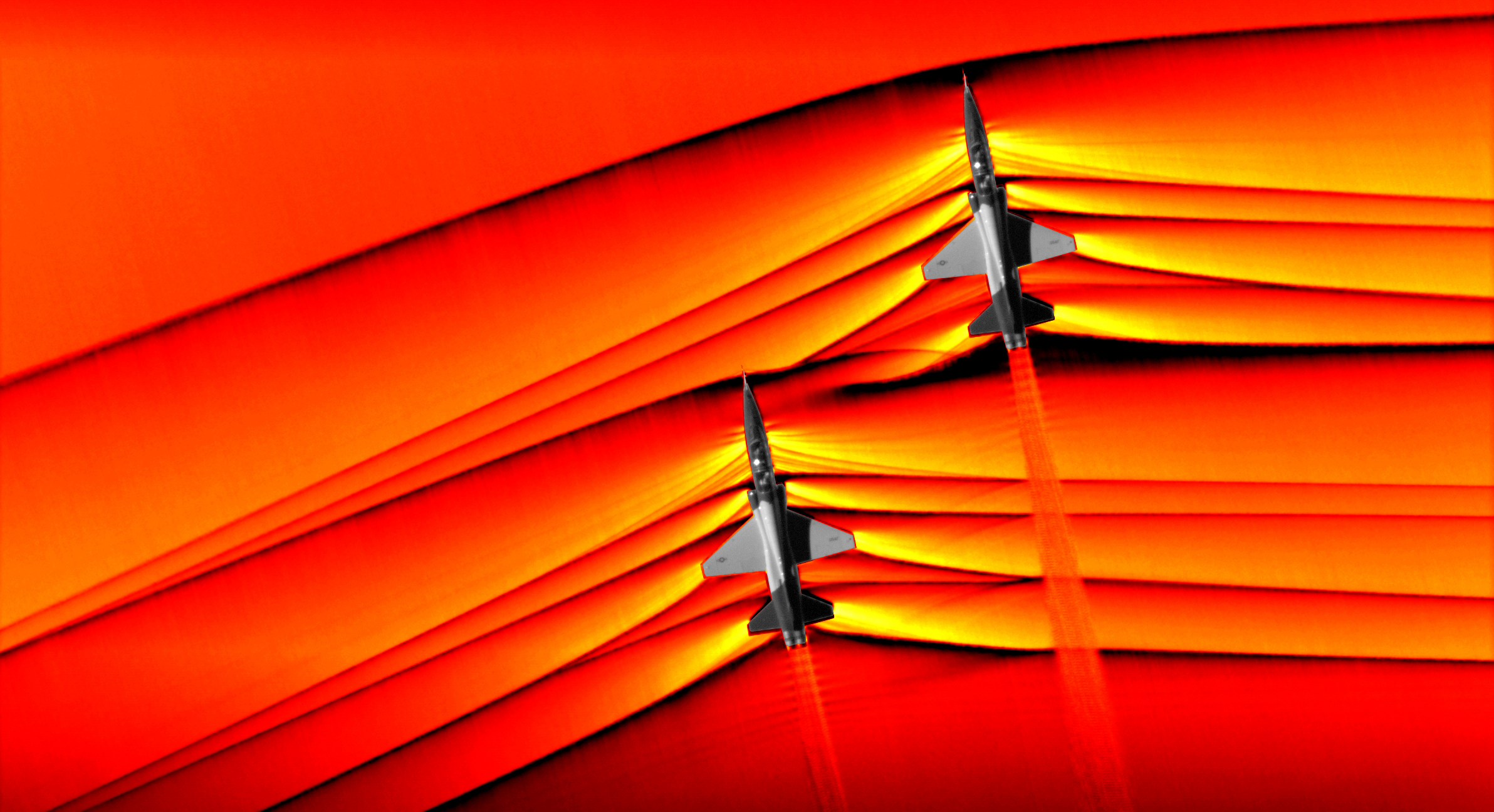
Credit: NASA, public domain, via Wikimedia Commons
You may remember the Concorde, the passenger jet that rocketed from New York to London in just three hours. And you may wonder, why do we now settle for much slower airplanes?
Speed is actually the reason. Achieving it required a great deal of maintenance and fuel, making the Concorde very expensive to operate.
But a bigger reason was noise. The Concorde flew at twice the speed of sound, so it created a sonic boom. It was so loud, the FAA prohibited it from flying across land, relegating it to transoceanic flights.
Few routes and high ticket prices meant the jet was unprofitable and thus taken out of service.
A sonic boom happens when an object exceeds the speed of sound, about 700 miles an hour depending on air temperature.
It pushes sound pressure waves in front of it so fast that they collide with each other, eventually fusing into a single shock wave that we hear as loud noise.
Bullets and bullwhips move fast enough to make small sonic booms. Lightning heats the air so fast that it expands faster than the speed of sound, which we hear as thunder.
New supersonic jets now in development are shaped so that the boom doesn’t reach the ground, creating a smaller effect that its designers call a “sonic thump.”
More research in these areas could see a “boom” in supersonic air travel in the future.
Background
Synopsis: When an object moves faster than the speed of sound, it becomes supersonic, breaking the sound barrier and creating a sonic boom. The sharp cracks of thunder, bullwhips, and bullets are familiar sonic booms. Some military aircraft and NASA’s space shuttles are supersonic, and commercial supersonic travel via the Concorde occurred from 1969 to 2003. While supersonic passenger travel doesn’t occur today, it may see a revival in the future.
- Sound is produced when an object vibrates, creating a pressure wave that moves nearby particles, transmitting the sound farther through the medium.
- The speed of sound depends on the medium through which the sound is traveling, increasing with temperature and (to a lesser extent) humidity.
- At sea level in dry air at a temperature of 68°F (20°C), the speed of sound on Earth is 1,125 ft/sec (343 m/s or 768 mph). In the thinner, colder atmosphere at an altitude of 20,000 feet, sound slows to about 968 ft/sec (295 m/s or 660 mph).
- On the moon there is no atmosphere, so there is no medium through which sound can be transmitted, so there is no sound.
- On the surface of Mars, the frigid (-81°F [-63°C]) carbon dioxide atmosphere transmits sound at about 792 ft/sec (240 m/s or 540 mph), slower than on Earth.
- Mach numbers describe how fast an object is moving compared to the speed of sound. Mach 1 occurs when an object is moving at the speed of sound.
- An object traveling slower than the speed of sound is said to be subsonic. Half as fast as the speed of sound would be Mach 0.5.
- Supersonic speeds are above Mach 1. The Concorde flew faster than Mach 2, which is twice the speed of sound.
- When an object exceeds Mach 5 it is said to be hypersonic. NASA’s space shuttles traveled at up to Mach 27.
- The speed of sound at sea level is 880,000 times slower than c, the speed of light. Light travels 186,000 miles in one second, while sound only travels the length of about three and a half soccer pitches in that same second.
- When an object exceeds the speed of sound, it creates a shock wave front. A sonic boom is the audible component of the shock front. They may exceed 200 decibels.
- The crack of a bullwhip comes when the tip of the whip exceeds the speed of sound, creating a small sonic boom.
- Modern firearms have supersonic muzzle velocities from 3,900 to 5,600 ft/sec (1,200–1,700 m/sec) that create the sharp bang of a rifle or pistol.
- Lightning heats the air, causing shock waves that make sonic booms—but you probably know them better as thunder! Lightning and thunder happen at the same time, but because light travels faster than sound, you see lightning before you hear thunder.
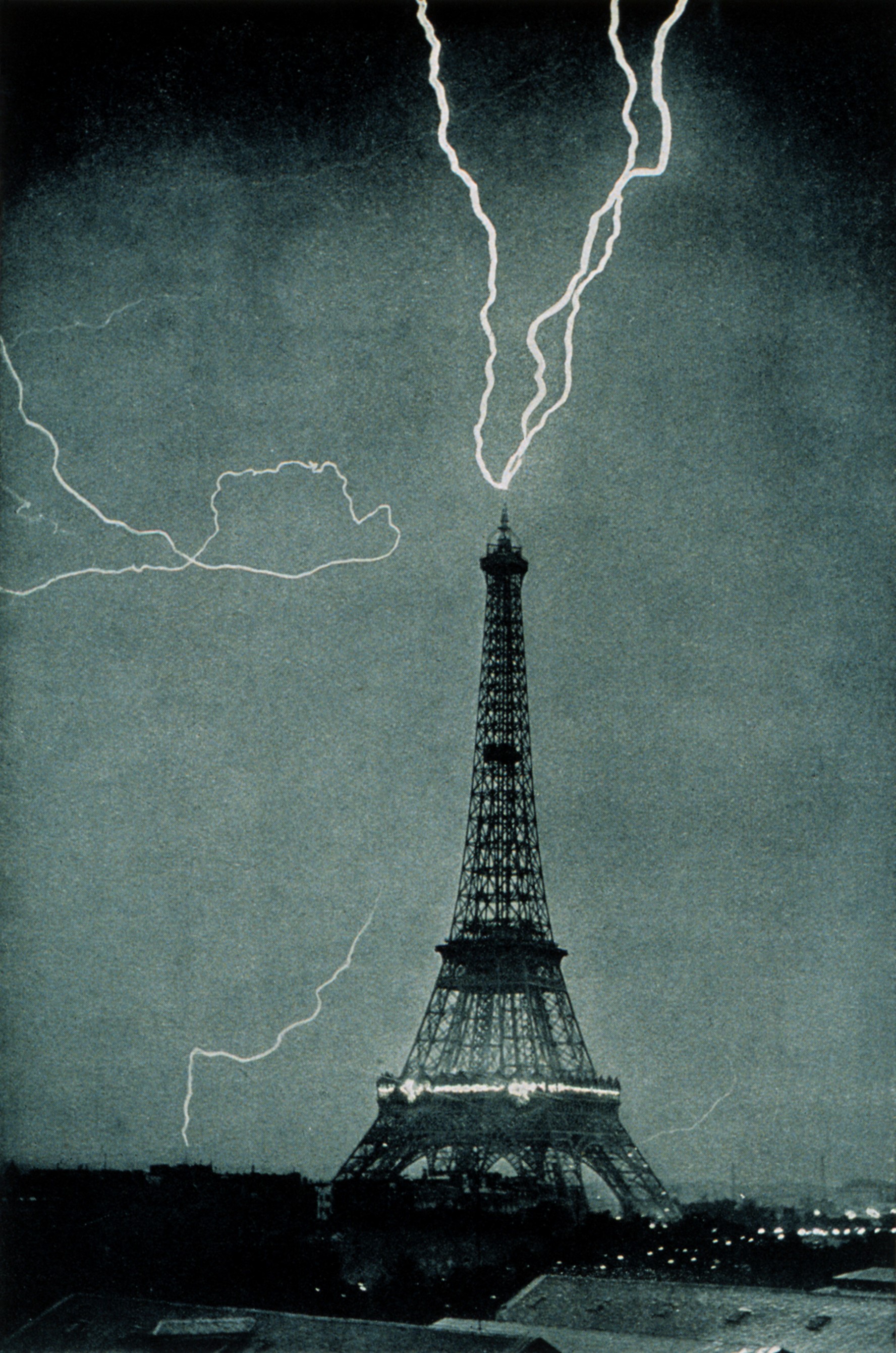
Lightning striking the Eiffel Tower, June 3, 1902, at 9:20 p.m., in one of the earliest photographs of urban lightning. Thunder is a sonic boom.
Credit: Gabriel Loppé, public domain, via Wikimedia Commons
- What causes sonic booms?
- As an object moves through the air it disturbs air particles in its path, creating compressional waves that travel at the speed of sound in all directions.
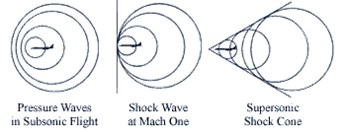
As an object moves through the air it creates a series of pressure waves in front of and behind it, similar to the bow and stern waves created by a boat. As the speed of the aircraft increases, the waves are forced together because they cannot “get out of the way” of each other, eventually merging into a single shock wave that creates a sonic boom.
Credit: Public domain via AcademicKids.com - As the object approaches the speed of sound it is said to be transonic, catching up to the sound waves in front of it and compressing them so that they pile up in the direction of travel.
- This impedes the forward motion of the plane, creating enhanced aerodynamic drag known as the sound barrier, which requires extra power to break through.
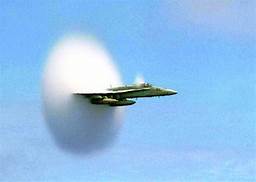
A U.S. Navy F/A-18 in transonic flight. The white water vapor cloud forms as a result of supersonic expansion fans that decrease local air temperature below the dew point, causing abrupt water vapor condensation.
Credit: Ensign John Gay, U.S. Navy, public domain
- As an object moves through the air it disturbs air particles in its path, creating compressional waves that travel at the speed of sound in all directions.
- Once the object exceeds the speed of sound it moves ahead of the compressed waves, creating a shock wave front that is perceived as a sudden, sharp sonic boom that can be heard continuously behind the plane, similar to the conical bow wave of a ship.
- The area where the sonic boom envelope intersects with the ground is called the boom carpet. It is about a mile (1.6 km) wide for each 1,000 ft (300 m) of altitude. A supersonic plane at 50,000 ft (15,200 m) can produce a boom carpet up to 50 miles (80 km) wide, with the highest sound intensity occurring immediately below the flight path.
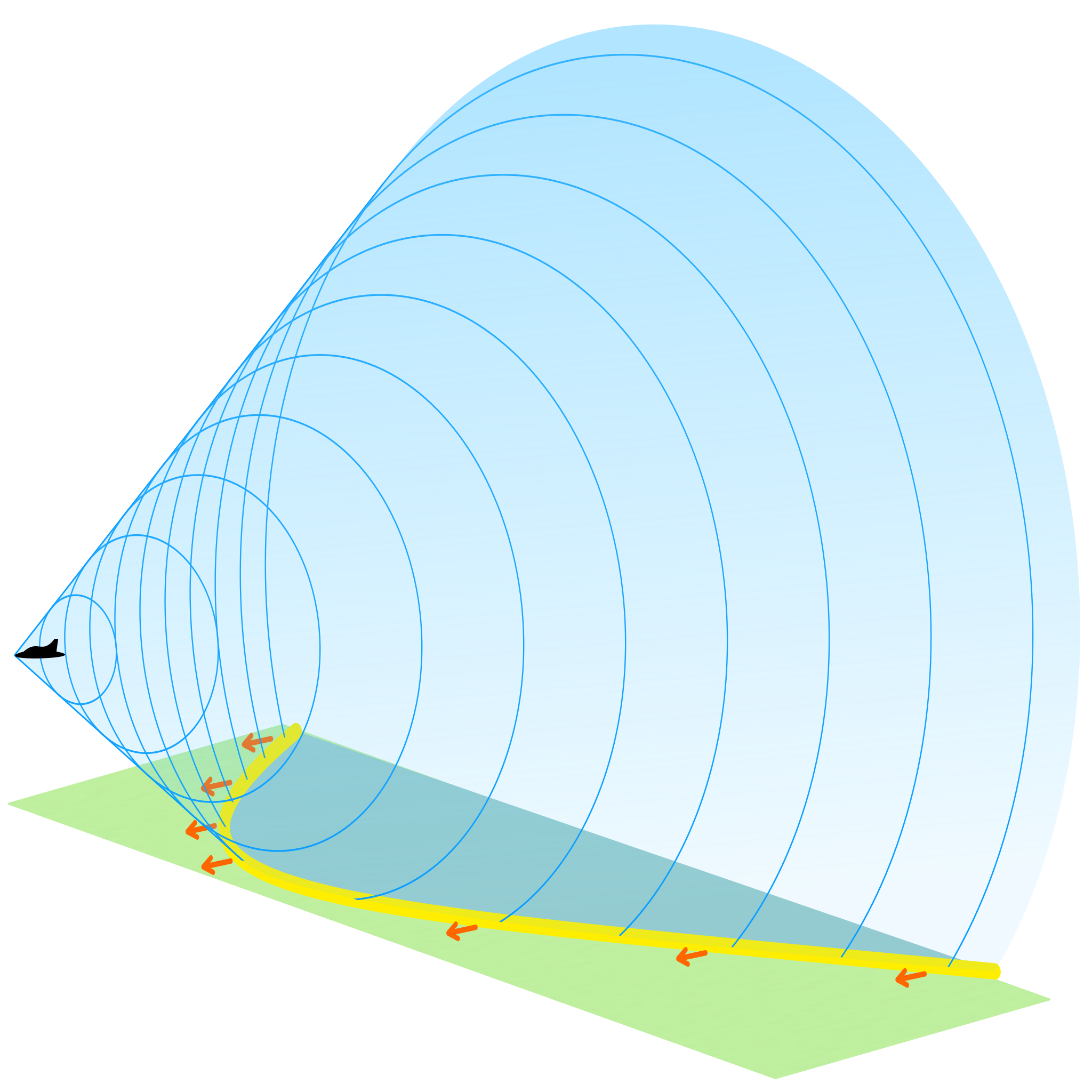
Illustration of the conical shockwave behind a supersonic aircraft with its hyperbola-shaped ground contact zone in yellow and its boom carpet in blue.
Credit: Cmglee, CC BY-SA 4.0, via Wikimedia Commons - A second sonic boom occurs when the boom envelope passes the observer as the pressure returns to normal.
- Pilots and passengers on the plane don’t hear the sonic boom because it follows the plane like a boat wake follows a boat.
- Extreme sonic pressure waves may cause damage to windows.
- The area where the sonic boom envelope intersects with the ground is called the boom carpet. It is about a mile (1.6 km) wide for each 1,000 ft (300 m) of altitude. A supersonic plane at 50,000 ft (15,200 m) can produce a boom carpet up to 50 miles (80 km) wide, with the highest sound intensity occurring immediately below the flight path.
- The first human to exceed the sound barrier in level flight was Chuck Yeager.
- On October 14, 1947, his small Bell X-1 plane was dropped from a modified Boeing B-29 bomber.
- Yeager fired the experimental thrust rocket engine and maintained controlled level flight (as opposed to an uncontrolled dive) to surpass the sound barrier, becoming the first supersonic human.
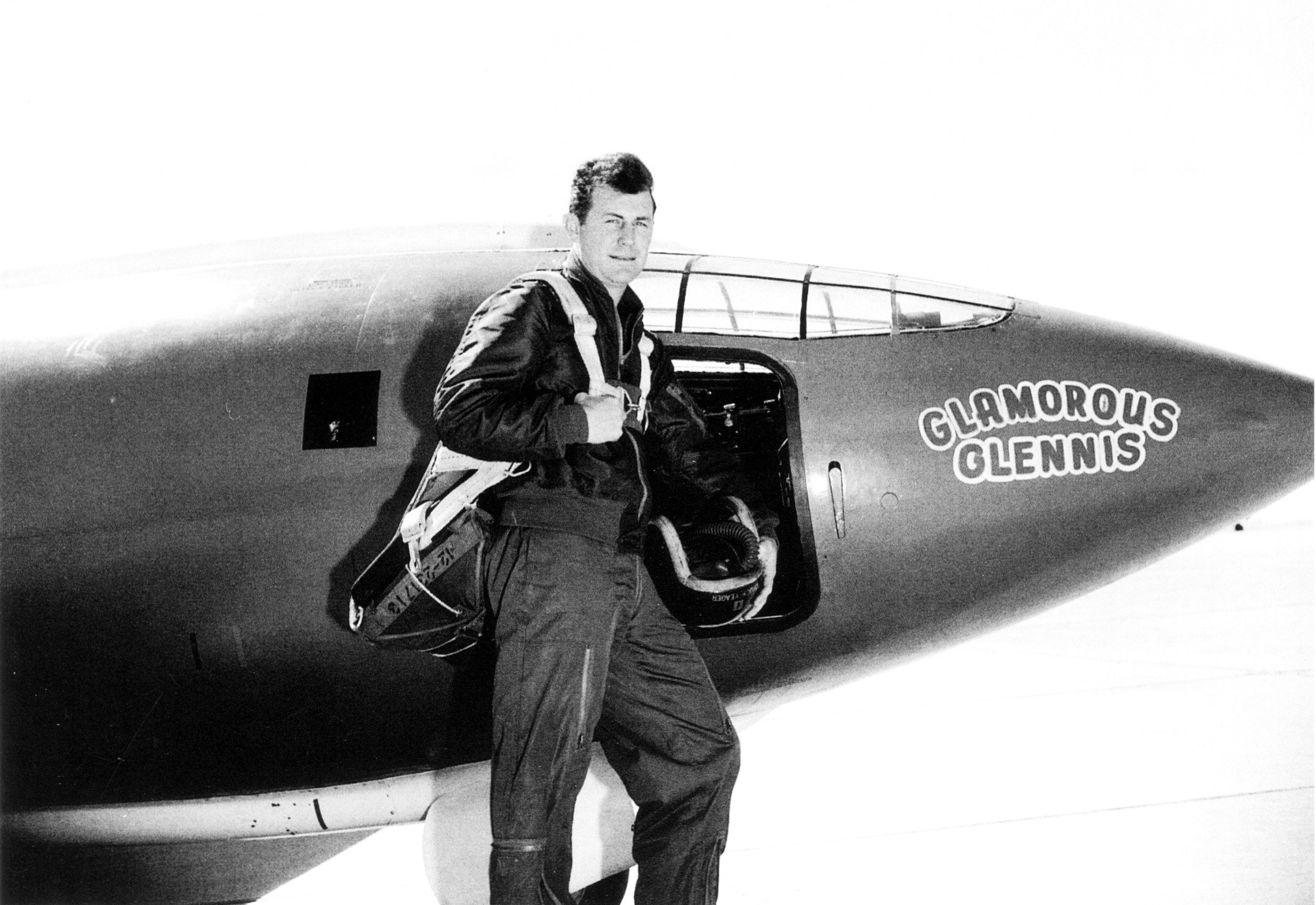
Chuck Yeager next to experimental aircraft Bell X-1 No. 1, Glamorous Glennis (named after his wife) in the 1940s.
Credit: U.S. Air Force, public domain, via Wikimedia Commons - Most supersonic flights have been in military or experimental aircraft.
- Supersonic flight decreased travel time for transatlantic passengers to just 3.5 hours but was fraught with environmental, safety, and commercial concerns.
- During the 1960s, aerospace engineers designed many supersonic airliners for commercial passenger use, and two were eventually put into service: the Soviet Tupolev Tu-144 (in service 1968–1999) and the Anglo-French Concorde (1969–2003).

Left: Tu-144 aircraft at Berlin-Schönefeld airport in 1971.
Right: British Airways Concorde G-BOAC in 1986.
Left Credit: Ralf Roletschek at the German-language Wikipedia, GFDL, via Wikimedia Commons
Right Credit: Eduard Marmet, CC BY-SA 3.0 and GFDL 1.2, via Wikimedia Commons
- During the 1960s, aerospace engineers designed many supersonic airliners for commercial passenger use, and two were eventually put into service: the Soviet Tupolev Tu-144 (in service 1968–1999) and the Anglo-French Concorde (1969–2003).
- The Tu-144 exceeded Mach 1 on June 5, 1969, becoming the world’s first supersonic airliner, and was the first to surpass Mach 2 on May 26, 1970.
- But crashes in 1973 and 1978 caused reliability concerns that limited use of the Tu-144 for passenger service to just 7 months in 1977 and 1978.
- It was used for cargo until 1983 and for research until 1999.
- The Concorde made its first flight on March 2, 1969, and first went supersonic on October 1, 1969.
- It could maintain sustained supersonic cruising speeds of Mach 2.04 (1,354 mph [2,179 km/h])—three times faster than regular airliners—at an altitude of 60,000 ft (18.3 km).
- Its first scheduled passenger service was on January 21, 1976, and its last was on October 24, 2003.
- In 1996, a New York to London ticket cost $7,574 ($12,460 in 2020 dollars). It was so expensive that flights were often only half full and unprofitable.
- Although hundreds were initially ordered, only 14 Concorde commercial airliners ever flew.
- Cost overruns and delivery cancellations were common, maintenance was expensive and the cost per passenger mile was more than double that of a Boeing 747.
- The biggest obstacles to continued commercial Concorde flight were the environmental and health impacts of the huge sonic booms. In 1973, the Federal Aviation Administration (FAA) created noise-abatement regulations that forbade supersonic flight over U.S. land, but the Concorde could still operate transatlantic flights since it always broke the sound barrier over the ocean.
- During a Concorde takeoff on July 25, 2000, debris from a burst tire caused a fuel tank to rupture, killing 113 people. This resulted in grounding of the whole fleet and plummeting customer trust, and after 9/11, the ultimate demise of supersonic passenger airline service in 2003.
- Today, engineers are working on ways to diminish the intensity of sonic booms, reducing them to sonic thumps in the design of modern supersonic transports (SSTs).
- Using advanced computer simulations, NASA’s X-59 airframe has been carefully shaped to reduce shock wave intensity and to direct shock waves away from the ground, with the hope of ultimately enabling overland supersonic flights.
- A focus on smaller supersonic business jets will also decrease the amplitude of sonic booms.
- Throttling down speeds so the boom envelope doesn’t reach the ground is another strategy under investigation.

